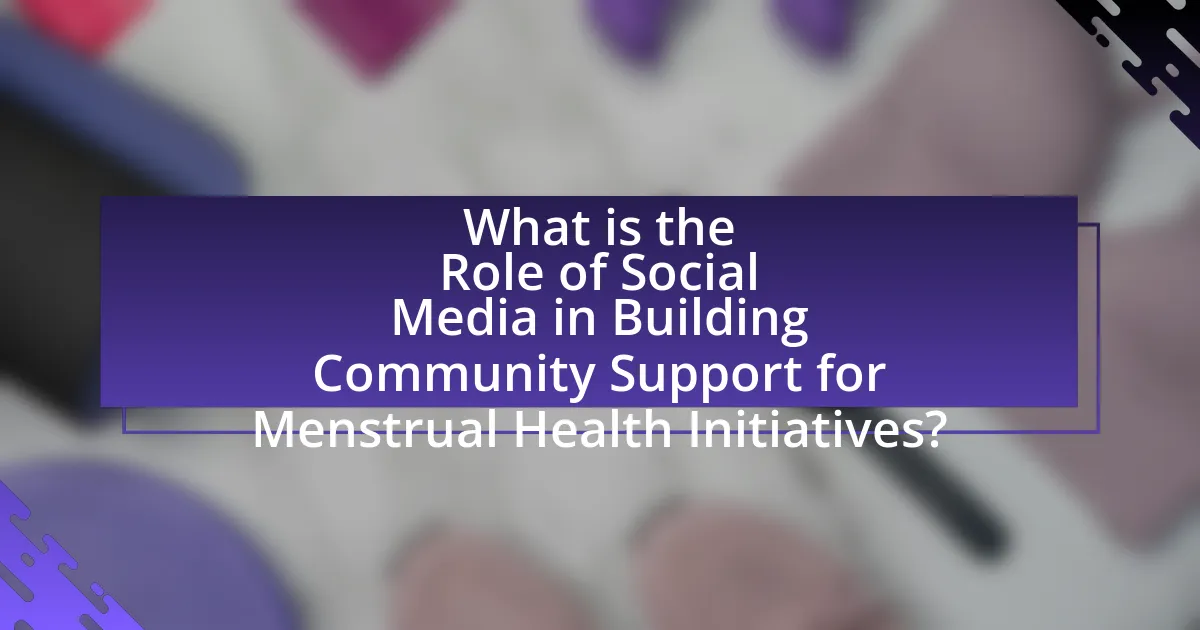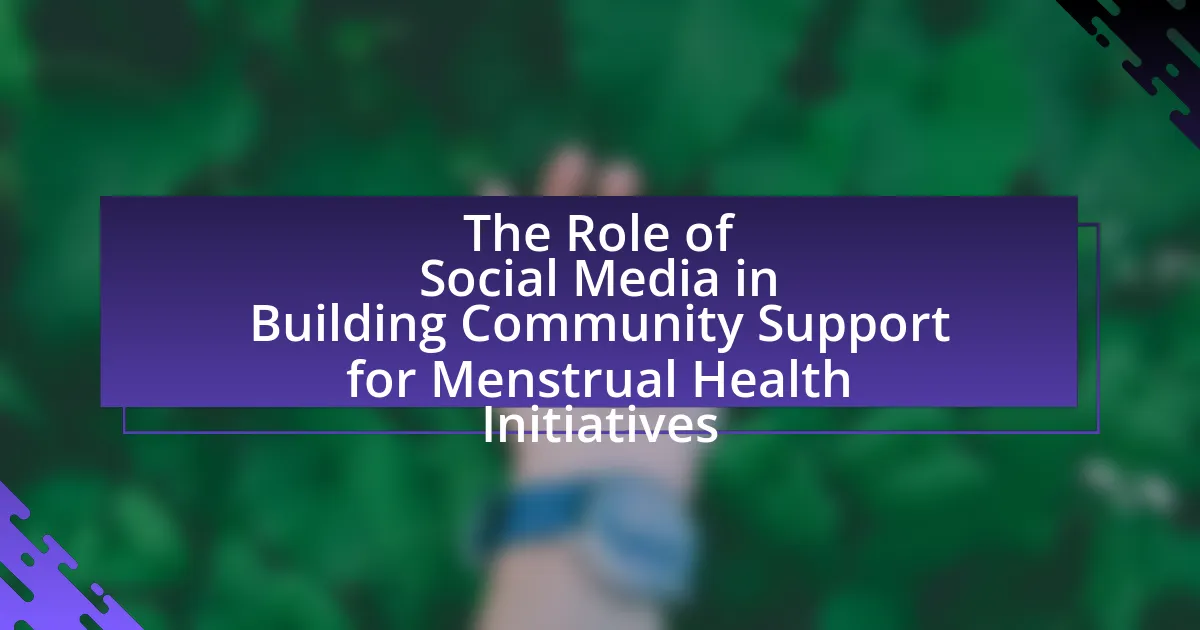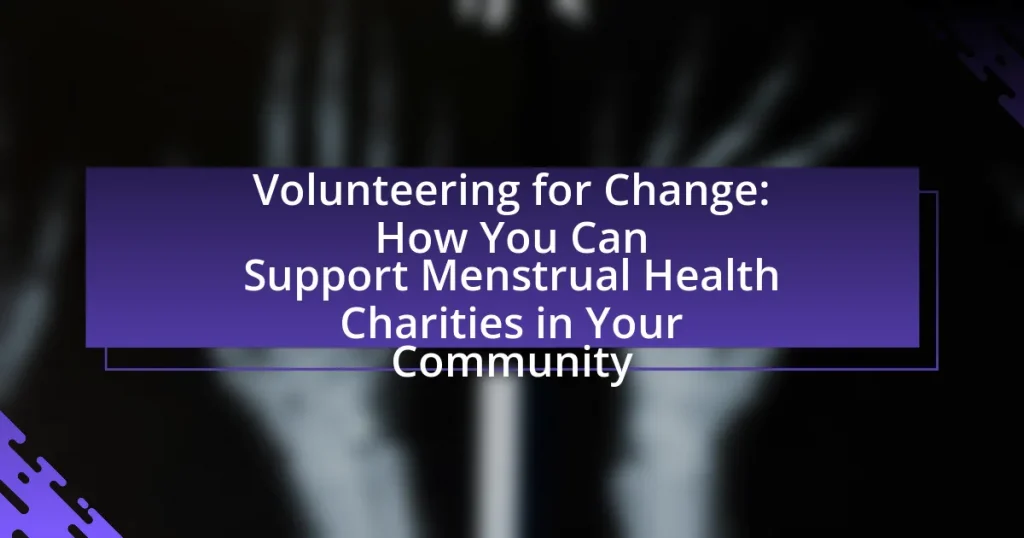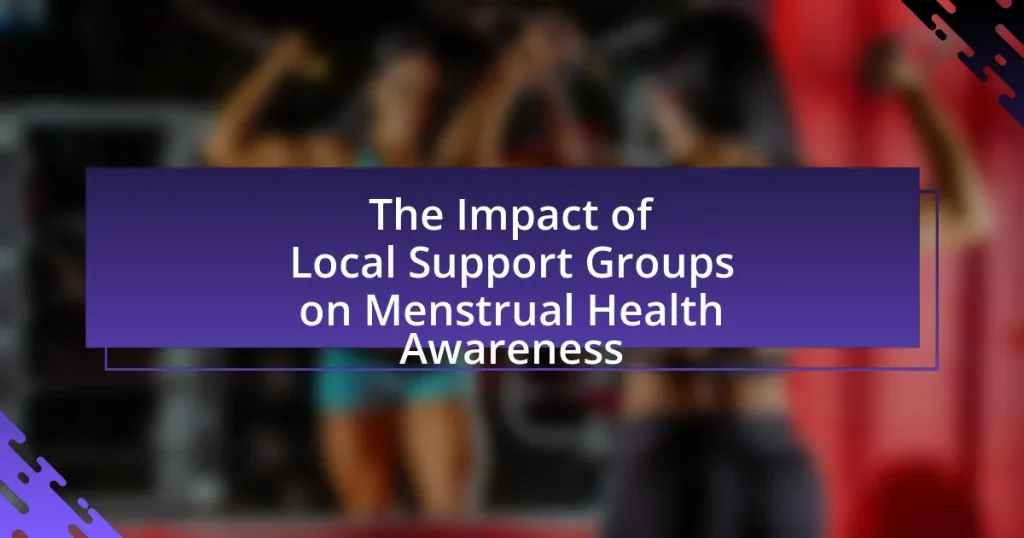The article examines the significant role of social media in fostering community support for menstrual health initiatives. It highlights how platforms such as Facebook, Instagram, and TikTok facilitate awareness, education, and engagement, thereby reducing stigma and promoting open discussions about menstruation. Key findings indicate that social media campaigns can effectively mobilize community support, enhance knowledge, and encourage participation in menstrual health initiatives. The article also explores effective strategies for leveraging social media, the impact of different demographics on engagement, and the challenges faced in promoting menstrual health awareness online.

What is the Role of Social Media in Building Community Support for Menstrual Health Initiatives?
Social media plays a crucial role in building community support for menstrual health initiatives by facilitating awareness, education, and engagement among diverse audiences. Platforms like Facebook, Instagram, and Twitter enable organizations and advocates to share information, personal stories, and resources, which helps to destigmatize menstruation and promote open discussions. For instance, campaigns such as #PeriodPositive have successfully mobilized communities to support menstrual health by encouraging individuals to share their experiences and advocate for policy changes. Research indicates that social media can increase knowledge and reduce stigma, as seen in a study published in the Journal of Adolescent Health, which found that social media campaigns significantly improved awareness of menstrual health issues among young people.
How does social media influence community engagement in menstrual health initiatives?
Social media significantly enhances community engagement in menstrual health initiatives by facilitating information sharing and fostering dialogue among users. Platforms like Facebook, Instagram, and Twitter allow organizations to disseminate educational content, share personal stories, and create supportive networks, which can lead to increased awareness and advocacy for menstrual health issues. For instance, a study published in the Journal of Medical Internet Research found that social media campaigns can effectively mobilize community support and participation, demonstrating a direct correlation between online engagement and increased attendance at menstrual health workshops and events. This evidence underscores the role of social media as a powerful tool for building community support and driving action in menstrual health initiatives.
What platforms are most effective for promoting menstrual health awareness?
Social media platforms such as Instagram, Facebook, and TikTok are most effective for promoting menstrual health awareness. These platforms facilitate visual storytelling and community engagement, allowing users to share personal experiences and educational content. For instance, a study published in the Journal of Medical Internet Research found that Instagram campaigns significantly increased awareness and knowledge about menstrual health among young users, demonstrating the platform’s impact on public health education. Additionally, TikTok’s short video format has been utilized by influencers to destigmatize menstruation, reaching millions and fostering open discussions.
How do different demographics engage with menstrual health content on social media?
Different demographics engage with menstrual health content on social media through varying levels of interaction, sharing, and content preference. For instance, younger audiences, particularly those aged 18-24, tend to engage more actively by sharing personal experiences and participating in discussions, as evidenced by a study from the Journal of Adolescent Health, which found that 70% of this age group uses social media for health-related information. In contrast, older demographics, such as those aged 35-50, may engage more passively, often seeking information rather than sharing it, as indicated by research from the Pew Research Center, which shows that 60% of adults in this age range prefer to consume content rather than create it. Additionally, cultural background influences engagement; for example, women from diverse ethnic backgrounds may seek community support through culturally relevant content, highlighting the importance of representation in menstrual health discussions.
Why is community support crucial for menstrual health initiatives?
Community support is crucial for menstrual health initiatives because it fosters awareness, reduces stigma, and enhances access to resources. When communities actively engage in discussions about menstrual health, they create an environment where individuals feel comfortable seeking information and assistance. Research indicates that community-driven initiatives can lead to a 30% increase in awareness about menstrual hygiene management, as seen in programs implemented in various regions. This collective effort not only empowers individuals but also encourages policy changes that improve access to menstrual products and education, ultimately leading to better health outcomes.
What are the key benefits of community support in promoting menstrual health?
Community support plays a crucial role in promoting menstrual health by fostering awareness, reducing stigma, and providing resources. Awareness is heightened through shared experiences and education within the community, leading to better understanding and acceptance of menstrual health issues. Additionally, community support helps to reduce stigma associated with menstruation, encouraging open discussions and normalizing the topic, which is essential for mental well-being. Furthermore, community networks can facilitate access to resources such as menstrual products and health services, particularly in underserved areas, thereby improving overall menstrual health outcomes. Studies have shown that communities with strong support systems report higher levels of menstrual health literacy and better health practices.
How does community support impact the success of menstrual health initiatives?
Community support significantly enhances the success of menstrual health initiatives by fostering awareness, reducing stigma, and facilitating access to resources. When communities actively engage in discussions about menstrual health, they create an environment where individuals feel comfortable seeking information and assistance. For instance, initiatives that incorporate community feedback and participation have been shown to increase the effectiveness of educational programs, as evidenced by a study published in the Journal of Adolescent Health, which found that community-driven approaches led to a 30% increase in knowledge about menstrual hygiene management among participants. This collaborative effort not only empowers individuals but also encourages collective action, leading to sustainable changes in attitudes and practices surrounding menstrual health.
What strategies can be employed on social media to enhance community support for menstrual health?
To enhance community support for menstrual health on social media, organizations can implement targeted awareness campaigns that educate users about menstrual health issues and promote open discussions. These campaigns can utilize infographics, videos, and personal stories to engage audiences effectively. Research indicates that visual content is 40 times more likely to be shared on social media, which can amplify the reach of menstrual health messages. Additionally, creating dedicated online support groups fosters a sense of community, allowing individuals to share experiences and resources. A study by the Pew Research Center found that 69% of adults use social media, making it a powerful platform for building supportive networks around menstrual health. Engaging influencers to advocate for menstrual health can also increase visibility and credibility, as their endorsements can reach diverse audiences.
How can storytelling be used to foster community engagement?
Storytelling can be used to foster community engagement by creating relatable narratives that resonate with individuals’ experiences and emotions. When stories highlight personal journeys related to menstrual health, they encourage open dialogue and shared understanding among community members. Research indicates that narratives can enhance empathy and connection; for instance, a study published in the Journal of Health Communication found that storytelling significantly increased participants’ willingness to engage in discussions about sensitive health topics, including menstrual health. By utilizing social media platforms to share these stories, communities can amplify voices, reduce stigma, and mobilize support for menstrual health initiatives, ultimately leading to a more informed and engaged community.
What role do influencers play in promoting menstrual health initiatives on social media?
Influencers play a crucial role in promoting menstrual health initiatives on social media by leveraging their platforms to raise awareness, educate audiences, and destigmatize menstruation. They often share personal stories, provide information about menstrual health products, and advocate for policy changes, which can significantly increase visibility and engagement around these topics. For instance, campaigns led by influencers have been shown to reach millions, effectively normalizing conversations about menstruation and encouraging open dialogue. Research indicates that social media campaigns featuring influencers can lead to a 30% increase in public awareness regarding menstrual health issues, demonstrating their impact in fostering community support and driving social change.
How can social media campaigns be designed to effectively support menstrual health initiatives?
Social media campaigns can be designed to effectively support menstrual health initiatives by focusing on education, community engagement, and advocacy. Educational content, such as infographics and videos, can disseminate accurate information about menstrual health, addressing myths and stigma. Community engagement can be fostered through interactive posts, polls, and discussions that encourage sharing personal experiences, thereby creating a supportive environment. Advocacy efforts can include calls to action, such as petitions or fundraising for menstrual health organizations, which mobilize followers to contribute to the cause. Research indicates that campaigns utilizing these strategies can increase awareness and drive positive change, as seen in the “Menstrual Health Matters” campaign, which successfully raised awareness and funds for menstrual health education in underserved communities.
What challenges do social media campaigns face in promoting menstrual health initiatives?
Social media campaigns promoting menstrual health initiatives face challenges such as stigma, misinformation, and audience engagement. Stigma surrounding menstruation often leads to reluctance in discussing menstrual health openly, which can hinder campaign reach and effectiveness. Misinformation about menstrual health can spread rapidly on social media, complicating efforts to provide accurate information and support. Additionally, engaging diverse audiences can be difficult, as varying cultural perceptions of menstruation may affect how messages are received. These challenges are supported by studies indicating that stigma and misinformation significantly impact public health communication efforts, particularly in sensitive topics like menstrual health.
What are the best practices for leveraging social media in menstrual health advocacy?
The best practices for leveraging social media in menstrual health advocacy include creating informative content, engaging with the audience, and collaborating with influencers. Informative content should focus on accurate information about menstrual health, addressing myths and stigma, and providing resources for education. Engaging with the audience through interactive posts, Q&A sessions, and polls fosters community involvement and encourages open discussions. Collaborating with influencers who are passionate about menstrual health can amplify the message and reach a broader audience, as studies show that influencer partnerships can increase engagement rates by up to 60%. These practices collectively enhance awareness and support for menstrual health initiatives.
How can organizations measure the impact of their social media efforts on community support?
Organizations can measure the impact of their social media efforts on community support by analyzing engagement metrics, such as likes, shares, comments, and follower growth, alongside sentiment analysis of user-generated content. These metrics provide quantitative data that reflects community interaction and support levels. For instance, a study by the Pew Research Center indicates that 69% of adults in the U.S. use social media, highlighting its potential reach and influence. Additionally, tracking specific hashtags related to menstrual health initiatives can reveal community sentiment and awareness, further validating the effectiveness of social media campaigns.
What common pitfalls should be avoided when using social media for menstrual health initiatives?
Common pitfalls to avoid when using social media for menstrual health initiatives include spreading misinformation, failing to engage the target audience, and neglecting privacy concerns. Misinformation can undermine trust and lead to harmful practices; for instance, inaccurate claims about menstrual products can deter individuals from using safe options. Engaging the target audience is crucial; initiatives that do not resonate with the community may fail to gain traction, as evidenced by studies showing that tailored messaging increases engagement rates. Lastly, neglecting privacy concerns can alienate users; research indicates that individuals are less likely to participate in discussions about sensitive topics if they fear exposure or judgment.
What practical tips can organizations implement to maximize social media’s role in menstrual health initiatives?
Organizations can maximize social media’s role in menstrual health initiatives by creating engaging, informative content that addresses common misconceptions and promotes open dialogue. This approach can include sharing educational posts, infographics, and personal stories that resonate with the audience, thereby fostering a supportive community. For instance, studies show that visual content is 40 times more likely to be shared on social media, which can significantly increase outreach and awareness. Additionally, organizations should leverage partnerships with influencers in the health and wellness space to amplify their message, as influencer marketing can yield a return on investment of up to $6.50 for every dollar spent. Regularly engaging with followers through Q&A sessions, polls, and live discussions can also enhance community involvement and trust, making the initiatives more relatable and impactful.



